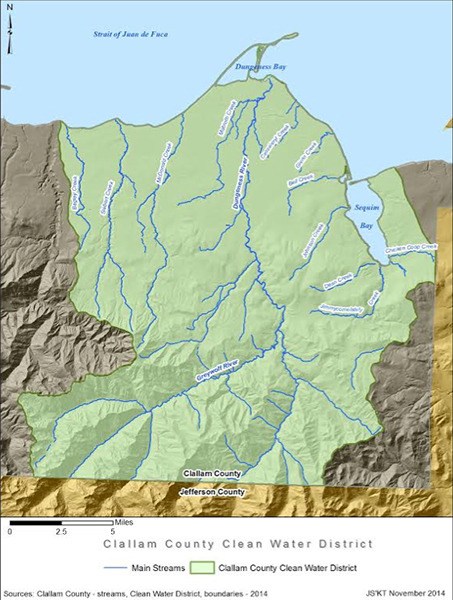Public comment period
When: Comments are accepted until Monday, Dec. 22.
Where: E-mail to jennifer.bond@clallamcd.org or call 775-3747.
More info: www.clallamcd.org
Bringing an 18-month project to a close, those involved with creating a Pollution Identification and Correction (PIC) Plan for the Sequim Bay-Dungeness Watershed Clean Water District have completed the draft plan and soon will begin a pilot project near Dungeness Bay.
The PIC plan provides the skeleton for how water pollution problems will be identified and corrected with the intention to improve local water quality and health of Sequim and Dungeness bays.
“Dungeness Bay is improving, but still not meeting water quality standards,” Amy Georgeson, Washington State Department of Health shoreline survey lead, said.
“We’re excited to see what comes out of this project and hope there are water quality improvements,” Georgeson said.
Each year a sub-watershed, like Bell Creek for example, within the Sequim Bay-Dungeness Watershed Clean Water District, which spans from Bagley Creek east to the county line near Diamond Point Road, will be targeted for PIC implementation.
Plan development
Clallam’s PIC plan is modeled after Kitsap County’s 1996 plan that first created an “organizational, strategic plan with how to deal with non-point pollution,” and has since turned into a “standard” for entities like the Department of Health and all other entities that do water quality work and work with shellfish protection, Andy Brastad, Clallam County Health and Human Services Environmental Health director, said.
“Basically defused pollution (non-point pollution) is the No. 1 problem in water quality now in the nation,” Stephanie Zurenko, Washington State Department of Ecology non-point compliance specialist, said.
Once officials with the Environmental Protection Agency got involved with a broader Puget Sound cleanup effort around 2010, both the Department of Health and Department of Ecology provided funding to pursue cleanup projects and eventually led to the development Clallam County’s own PIC plan.
“Department of Health is really requesting all health jurisdictions within the Puget Sound area to develop these pollution, identification and correction plans,” Brastad said. “Twenty years ago is when it started, but now it is really front and center for all the health jurisdictions.”
Because of limited staff and time at the county’s Health and Human Services office, officials with the Clallam Conservation District took on the task of coordinating and developing the draft plan.
“We’ve solved some water quality issues, but there are still some problems so we just thought that we needed better coordination on how we identify these problems,” Jennifer Bond, Clallam Conservation District conservation planner, said.
The district also was interested in more strategic water quality monitoring, clarifying when and how enforcement activities occur and exploring additional funding options for actually making some improvements and changes in water quality, she said.
Action
Utilizing a $279,444 grant from the Washington State Department of Health, county officials are preparing to kick start the PIC plan with a pilot project beginning in early 2015 through 2017 targeting Golden Sands Slough, Meadowbrook Creek and slough and Cooper Creek. Depending on the success of the project, additional sub-watersheds may be incorporated.
“From the water quality data we already have on these creeks we know there are some pollution problems,” Bond said. “Also, they are in close proximity to Dungeness Bay and the Department of Health is focused on that area.”
Through collaboration with surrounding landowners and project partners including the Streamkeepers, Jamestown S’Klallam Tribe, Clallam County Health and Human Services and Clallam Conservation District, Brastad hopes to “build in efficiency” by working together under one grant and plan instead of working independently.
“This is really the first time we’ve tried to take a look at non-point pollution as a whole and not be parted out,” Brastad said. “This time around we’re trying to make it a more cohesive type of a teamwork project.”
In order to identify potential pollution sources such as septic systems, livestock, pets and wildlife, project partners hope to be monitoring and collecting data within the project area by spring.
Impact
However, prior to any action at Golden Sands Slough, Cooper Creek, Meadowbrook Creek and slough, residents within the project area will be notified via the mail.
Because water quality sampling is the “key” to identifying sources of pollution, residents may be asked for permission to take water samples from their property, Bond explained during a public meeting on the PIC plan Thursday, Dec. 11. “What we really want to do is work with landowners, try to understand the problems and try to help,” Brastad said. “There are at least two loan programs for people are who financially strapped, but still need to do something about a septic system. We are doing our best to make resources available to people to fix things.”
Clallam Conservation District personnel also will be conducting community outreach and education as part of the PIC plan.
“Part of the plan is trying to keep open communication between involved agencies and the community,” Brastad said.
Moving forward once the grant period comes to a close, Bond estimates the ongoing annual cost associated with the PIC plan is about $243,000.
“At this point, the annual costs do not include the corrections and so we’re relying on grant funding,” Bond said.
Potential future funding sources include funds from the county’s general fund, shellfish protection district financing, conservation district special assessment, rates and charges, surface and stormwater management funding, on-site septic operating permits and both state and federal grants.
Public comments are being accepted by the Clallam Conservation District until Monday, Dec. 22, with the expectation to have a final plan by January.
Copies of the PIC plan are available on the Clallam Conservation District’s website at www.clallamcd.org.
Reach Alana Linderoth at alinderoth@sequimgazette.com.



